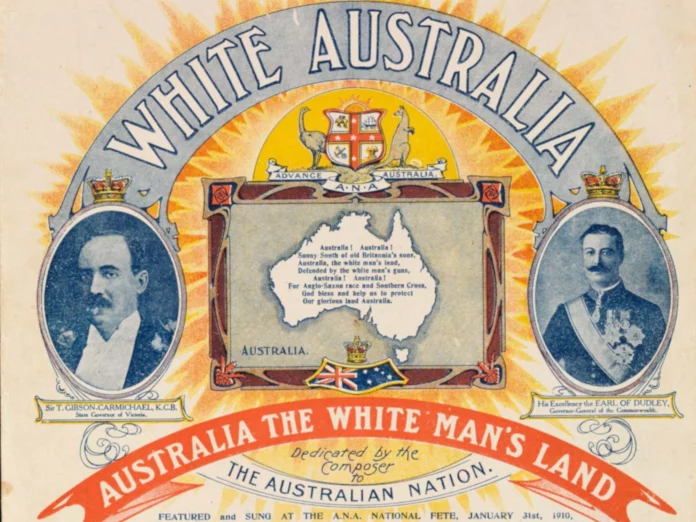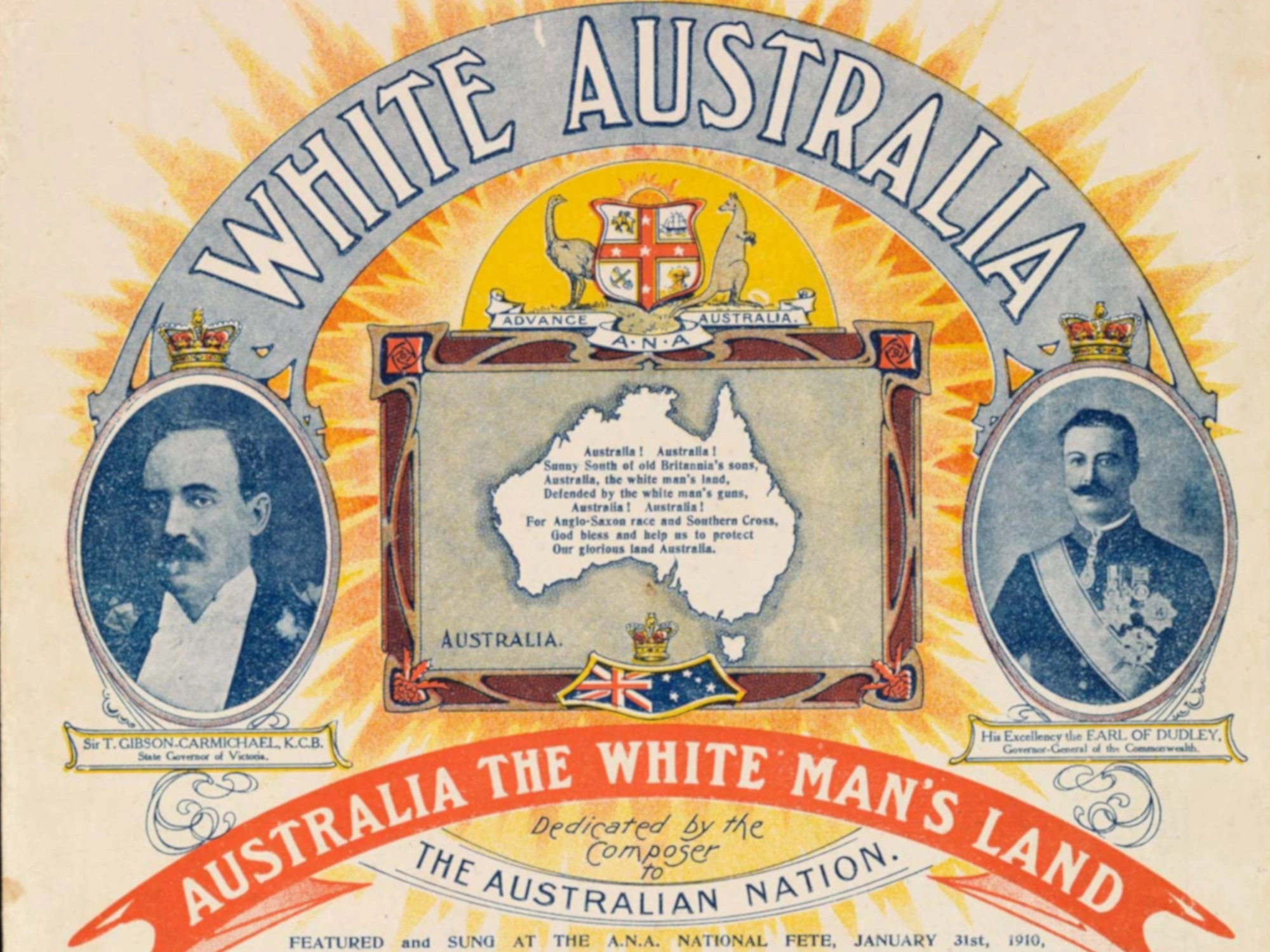Originally published by The Occidental Observer.
Jason Cannon
Censorship and the White Australia Policy
Broader ideological connections between the anti-censorship cause in the post-war era and the crusade against White Australia are also apparent, and the contribution of Jews, as well as their literature at the cultural vanguard, was in part responsible for a major ideological shift in the character of the anti-censorship cause. Prior to the 1960s, it was the overtly political nature of censorship in Australia that aroused the most indignant opposition. Censorship of the press occurred during both World Wars, and the banning of communist and other socialist works—as well as books like Huxley’s Brave New World and Orwell’s Down and Out in Paris and London—was a point of contention for the intellectual class, who argued such censorship restricted political freedoms. There was also a strong strand of “anti-wowserism” among the intellectual class that sought to improve the poor cultural standing of Australia and combat what was perceived to be excessive puritanism. ‘Wowser’, an outdated Australian term, was defined as an overly zealous or puritanical person, in particular those who campaigned for temperance. Moralistic attempts to ban even things like comic strips or cheap “paperback junk” arguably backfired and gave far more credibility to the later anti-censorship cause than it otherwise would have had. Instead of Reich-reading revolutionaries who hated the racial status quo, prominent anti-censorship advocates prior to 1939 included the likes of artist/author Norman Lindsay and his close associate P.R. Stephensen, a now forgotten nationalist intellectual who was imprisoned during the war for his Axis sympathies. In the wake of a politically embarrassing banning of J. D. Salinger’s Catcher in the Rye, reforms in 1954 by Liberal Prime Minister Robert Menzies largely rectified the heavy-handed nature of earlier prohibitions. As such, in the run up to Portnoy’s Complaint, just about the only publications that were still being banned were those of a particularly sexually obscene nature, works such as The Painted Bird, or the explicit pornography that was beginning to appear.
It was the banning of James Baldwin’s Another Country in 1963 that for the first time brought the White Australia Policy directly into the picture when it came to censorship debates. Censorship opponents were by now fully under the sway of Boasian ideas of racial equality, and they argued that the ban on Another Country would be interpreted as an act of racial prejudice.[20] At a time when Australia’s racially restrictive immigration policy was coming under international pressure, it was this new breed of anti-censorship activists explored in this essay that were taking up leadership roles and shifting the nature of the cause into a revolutionary endeavour to upend every aspect of Australian society in sexual as well as racial terms. Obscenity laws were increasingly seen as a crucial bulwark against the creation of a new sexually liberated and racially diverse Australian society. To free Australia from racialism and rid itself of the White Australia Policy, it was seen as necessary to first rid the country of the fear of sex and foreign contamination argued to be implicit in the establishment of obscenity laws and importation restrictions. Critics such as Geoffrey Dutton, who was one of Graham C. Greene’s local contacts, lambasted censorship as being merely a small part of the broader moral and racial protectionism of Australia, seeking to isolate itself in a “pure all-white paradise” protected from corrosive foreign influences.[21] Seizing upon the ideological similarities between the impetus behind immigration restriction (i.e., protection of Australia from Chinese migrants and cheap coloured workers) and censorship in protecting Australia from foreign moral influences, Dutton clearly enunciated the case for the discarding of censorship laws not simply on the grounds of literary merit or the ability for an adult to decide for themselves what works they should be allowed to read, but on the removal of racial and moral protectionism. The Jewish newspaper editor and columnist Cyril Pearl, another veteran of the anti-censorship campaign who made an appearance for the defence at the first NSW Portnoy trial, mockingly referred to censorship as “a part of the White Australia Policy”[22] and the radicals of OZ and the student press also saw their participation in strong racial terms.
The editorial line of OZ consistently agitated against the White Australia Policy in unison with their case against obscenity laws. A perfect example of this is found in Edition 18 of the magazine from April 1965. As a cover story, OZ reviewed the statement of policy of a new conservative magazine set to be published, the “Australian International News Review,” which eventually ran for only 17 issues and ceased operation two years later. Published in-full by OZ, this statement of policy included the following points:
News Review supports severely restricted immigration to prevent the development of a colour problem and its consequent danger to Australia.News Review is utterly opposed to the present mass exploitation of the sex theme and the impetus it gives to increasing moral delinquency throughout the commonwealth.[23]
The editors of OZ were hysterical in response, and revealed the connection they saw between the two causes:
And now, when there is some stirring of the forces proposing such basic civil liberties as less severe censorship and racial equality, we are about to have the “National Review.” … The excerpts reproduced here … indicate clearly what these policies are. The words “Fascist” and “Nazi” are smear-words more often abused than correctly directed these days; but if any policy deserved such a description, this is it, with its careful blend of national jingoism and Anglo-Saxon racialism.
The publisher Graham C. Greene would later become involved with the global anti-apartheid movement that was attempting to overthrow the white minority government in South Africa. Under his leadership, Jonathan Cape published the works of Jewish author Nadine Gordimer, a member of Nelson Mandela’s African National Congress whose novels Burger’s Daughter and July’s People fantasied the violent political overthrow of the South African government—works for which she won the 1991 Nobel Prize for Literature.
The Pornographic Era Begins
The immediate winner of the collapse of Australia’s obscenity laws was of course not literature, but pornography. Within two years, the country was already becoming awash with smut, and authorities around the country attempted to stem the tide:
By 1974, the New South Wales Government was complaining that Sydney had been “flooded” with pornography. … The Queensland Literature Board of review sought to step in where the federal government had retreated and set about prohibiting an increasing amount of material. It banned ninety-three publications in 1972–1973, sixty-seven in 1973–1974, eighty-two in 1974–1975, and eighty-eight in 1975–1976.[24]
Locally produced sex comedies with R18+ ratings like Alvin Purple were reaching cinemas in late 1973, but the majority of pornographic material was (and still is) coming from the United States. The consequences of this collapse and the shift to the supposed “control” and classification of publications is plain for everyone to see. Hardcore pornography now brims from our screens and laptops, freely accessible by any child with an internet connection and inattentive or lax parents; every sexual perversion imaginable is openly discussed and displayed on television and in films; streaming networks Netflix and HBO commission shows about teenagers that graphically depict sex, drug use, miscegenation, and the celebration of sexual immorality[25]; sexual lyrics are practically mandatory in the pop songs that emanate from Spotify playlists and the radio; and smutty literature sits in the bestseller sections in bookshops. The broader influence of internet pornography and the prominent Jewish role in this, as well their role in the birth of the pornographic industry itself, is beyond the scope of this essay. Nevertheless, by the 1990s internet pornography was the coup de grâce of a global Jewish effort of moral subversion and social engineering that successfully disintegrated the final remnants of obscenity law that remained in the West. With the arrival of internet porn, the Australian government had lost any effective ability to dictate the reach and accessibility of obscene pornographic material in society.
Obscenity controls have now vanished from Western countries, but the underlying propensity to ban and restrict that which is believed to be harmful or destructive to your culture and religion (this being the essence of the intent behind obscenity laws) has not. Over the course of the last 60 years, the political and cultural power to enact censorship laws and to enforce these restrictions over society has rather shifted to Jews who subsequently inverted the political mechanisms previously used by obscenity laws to suit their own purposes. Instead of the idea of obscenity (that which is harmful to Christianity and Western people), we now have the idea of “hate speech”—that which is harmful to the Jews. Accordingly, our culture no longer bans pornography or works like Portnoy’s Complaint, and instead bans only ”anti-Semitic” material and “racist” and “hate” publications. Similarly, depictions of homosexual behaviour used to be considered obscene; now to be against homosexuality is to engage in “hate speech,” which, as we are always told, inevitably leads to another holocaust. These new hate speech controls, which are in every sense a substitution of obscenity controls, have been enshrined into law across the West and hate speech policies operate on all major social media platforms. In Australia, hate speech laws have been in force since 1995, under Section 18c of the Racial Discrimination Act. The law came into existence as a result of Jewish ethno-political activism and Jews continue to defend the law with the utmost ferocity against any gentile who dares to attempt to weaken it.[26] Dennis Altman argued in 1970 that censorship acts “not only to preserve good taste, but also to exclude radical critiques.”[27] By the same token, hate speech laws act to exclude radical critiques of Jews and their actions. In all, the Customs Official with his government list of prohibited books has not disappeared, he has simply been replaced by the Amazon Employee and his digital register of books deemed by Jewish groups like the ADL to be hate speech.
A Depraved Youth
As was constantly (and mockingly) pointed out by opponents of censorship, being exposed to one single obscene book on its own won’t necessarily deprave a reader, but being exposed to a lifetime of pornography and sexual content, to such an extent that it is considered a normal state of affairs, certainly can. Presently our youngest generation of men and women are practically raised on the sort of hyper-sexual content uploaded to all their favourite social media sites like TikTok, Reddit, Instagram and YouTube, and are a demographic consistently identified by researchers as having strong porn-viewing habits. A government survey from 2017 found that 44 percent of Australian children between the ages of 9–16 experience regular exposure to sexual images,[28] and another study of exposure to explicit pornography found that the median age an Australian child first views pornography is 13 in boys and 16 for girls. The study also found that “LGBTI children” watch pornography more frequently and from a younger age.[29] One can confidently assume these figures have only gotten worse in the intervening years, but as anyone who attended high school in the last two decades can tell you, online pornography viewing is rampant amongst teenagers. In the distant days of porn videotapes/magazines, or when an internet connection meant a fixed computer monitor sitting in middle of a living room, viewing pornography was a more complicated affair. Nowadays it is discreetly and effortlessly accessed on portable laptops and phones, and the proliferation of personal mobiles and other such handheld devices amongst children has removed almost any last control that parents had on pornographic or other hyper-sexual exposure. Far from ushering in a period of sexual decency and health as was predicted by some of the anti-censorship activists, Australia in the aftermath of Portnoy’s Complaint now grapples with a crisis of abnormal sexuality, pornified culture, and a seeming epidemic of sexual harassment and other sex crimes. A slew of sex scandals, sexual harassment claims and rape allegations have hit the Australian political scene over the last four years, prompting all kinds of exposés about a culture of sexual misconduct that exists in even the highest offices in the land. The worst incidents include a case of rape that occurred inside the Australian parliament building, and a political staffer who outdid Portnoy himself by being caught masturbating onto the desk of a female Member of Parliament and sharing pictures of the act to his colleagues.[30]
Moreover, the obvious link between the hyper-sexualisation of society that was unleashed with the defeat of obscenity laws and the modern outrage over such incidents and things like “rape culture” and the misogynistic impact of pornography on the male mind continue to be ignored by progressives. At no point in his book can Patrick Mullins bring himself to make these connections (nor the Jewish connections for that matter), as to do so would be to undermine the moral and political “victory” that Portnoy’s Complaint delivered for the left. The best he can muster is a few bland sentences about the “increase in availability of and demand for pornography”[31] absent from any extrapolation of the impact this has had. Also ignored are the former comrades-in-arms against obscenity who later renounced their work when the consequences of liberation became apparent. Peter Coleman’s 1962 book Obscenity Blasphemy Sedition is still a standard work on the history of censorship in Australia, written when Coleman was under the spell of Jewish academic Henry Mayer, but he has since turned against it:
It is also the one book that I later renounced. I began it with the idea of striking a blow for the total abolition of censorship. By the time I delivered it to the publisher, I was beginning to have doubts about the abolitionist cause, libertarianism in general, and even Henry [Mayer] as “guide, philosopher and friend”. (He remained a friend.) It was too late to rewrite it, although in later editions I added some “second thoughts”. Critics welcomed the new editions but not my second thoughts.[32]
As for sexually healthy relations, increases in STD rates are prevalent across the West, and our society now must deal with the abhorrent spectacle of young men, inspired by hardcore pornography, strangling women to death during sex, or ordinary young women making money by selling naked images of themselves on the internet via websites like Onlyfans. Originally a non-sexual content subscription service, Onlyfans was purchased in 2018 by Ukrainian-born businessman Leonid Radvinsky, the latest in a long line of Jewish porn-tycoons, who promptly turned the site into a hub for selling pornography and sexually explicit content, utilized by prostitutes and underage girls alike.
The Australian Reich
The spectre of Wilhelm Reich looms large in the conflicts over obscenity encapsulated in this essay—a figure whose ideas, as briefly alluded to, provided much of the basis for the anti-censorship critique from the 1960s onwards. Years after his death, Reich was hitting new heights of popularity with the student revolt and the ’68 generation at the same time that Portnoy’s Complaintlanded on Bennet Cerf’s desk. Identifying Australian political and cultural figures over the course of the 1960s who directly read and comprehended his works is difficult to uncover, but what is clear is that by the turn of the century the ideas of Reich had fully permeated the culture. The erstwhile defender of Australian obscenity laws during the Portnoy battle, former Customs Minister Don Chipp, could be found in 2003 practically repeating the lines of Reich’s The Mass Psychology of Fascism:
Tomorrow, in a speech for the Eros Association, he [Don Chipp] will issue a warning: censorship of sexual content opens the door for political censorship, deprivation of civil liberties and totalitarianism.[33]
Reich, writing during the ascension to power of German National Socialism, saw the revolutionary value in promoting the sexualization of children—something which his most devoted disciples during the sexual revolution sought to accomplish. He understood that a society of gentiles befuddled and distracted by sex and pornography—one where political energy and moral outrage has been redirected or blinded by sexual passions—is a docile society where an anti-Jewish reaction can never take deep root:
If we could once succeed in engaging the sexual interests of children and adolescents on a mass scale, then reactionary contamination [fascism] would be faced with a tremendous counterforce—and political reaction would be powerless.[34]
As long as the masses are too busy masturbating, having casual sex and letting their children watch porn, then the West lacks the moral clarity, let alone the political ability, to attempt to curb Jewish influence on our culture. So as it turns out, Gershom Scholem and the Australian Rabbis were wrong. In bringing down Australia’s obscenity laws and leading the way for the pornographic era and the mass sexualization of children and broader society, Portnoy’s Complaint was in fact good for the Jews of Australia—but don’t expect that admission to come from them any time soon.
Bibliography
[1] P. Mullins 2019, The Trials of Portnoy, Scribe Publications, Australia.
[2] For a while seditious works were also prohibited in Australia.
[3] Mullins, op. cit., p.30.
[4] The defendant Wald was Jewish abortionist Louis Wald, a practitioner at the Heatherbrae Clinic in the suburb of Bondi, at the time the largest illegal abortion clinic in Australia.
[5] Mullins, op. cit., p.40.
[6] Mullins, op. cit., p.45.
[7] High Court of Australia, Crowe v Graham Judgement,retrieved from: https://staging.hcourt.gov.au/assets/publications/judgments/1968/078–CROWE_v._GRAHAM–(1968)_121_CLR_375.html
[8] Mullins, op. cit., p.147.
[9] Mullins, op. cit., p.32.
[10] Mullins, op. cit., p.62.
[11] Australian Jewish News, Portnoy—A Series of Complaints, 30 September 1970, p.11.
[12] Mullins, op. cit., p.64.
[13] E. Michael Jones, 2008, Chapter 30 The Messiah Arrives Again. In: The Jewish Revolutionary Spirit, Fidelity Press, USA, p.974.
[14] Mullins, op. cit., p.69
[15] Mullins, op. cit., p.261.
[16] Commonwealth of Australia, 2011 Review of the National Classification Scheme: achieving the right balance, Legal and Constitutional Affairs References Committee, p.30.
[17] Mullins, op. cit., p.197.
[18] Ibid., p.62.
[19] E. Connelly, 2018 ‘Harvey Weinstein: On Jews and the Shiksa’, The Occidental Observer, retrieved from: https://www.theoccidentalobserver.net/2017/10/18/harvey-weinstein-on-jews-and-the-shiksa/
[20] Mullins, op. cit., p.25.
[21] G. Dutton 1970, Moral Protectionism, In: Australia’s Censorship Crisis, (eds) G. Dutton and M. Harris, Sun Books, Australia, p.96-104
[22] S. Murray-Smith 1970, Censorship and Literary Studies, In: Australia’s Censorship Crisis, (eds) G. Dutton and M. Harris, Sun Books, Australia, p.79
[23] OZ Magazine, Edition 18, April 1965, University of Wollongong Archives, Call no. 052/47. Retrieved from: https://archivesonline.uow.edu.au/nodes/view/3498/
[24] Mullins, op. cit., p.257.
[25] Examples include Sex Education on Netflix or Euphoria on HBO, the latter created by Jew Sam Levinson and based upon an Israeli TV show.
[26]See B. Sanderson 2014, ‘Australian PM Caves in to Jewish Lobby on Free Speech Laws’, The Occidental Observer, retrieved from https://www.theoccidentalobserver.net/2014/08/08/australian-pm-caves-in-to-jewish-lobby-on-free-speech-laws/
[27] Mullins, op. cit., p.47-48.
[28] A. Quadara, A. El-Murr, & J. Latham 2017 The effects of pornography on children and young people: An evidence scan (Research Report), Australian Institute of Family Studies, Melbourne, retrieved from: https://aifs.gov.au/sites/default/files/publication-documents/rr_the_effects_of_pornography_on_children_and_young_people_1_0.pdf
[29]M. Lim, M, et. al. 2017 ‘Young Australians use of pornography and associations with sexual risk behaviours’, Australian and New Zealand Journal of Public Health, retrieved from:https://www.burnet.edu.au/system/asset/file/2649/Pornography_ANZJPH_paper.pdf
[30] K. Curtis & A. Livingston 2021 ‘‘Sex act on female MP’s desk’: Liberal staffer sacked over lewd video’, Sydney Morning Herald, March 22nd, retrieved from: https://www.smh.com.au/politics/federal/sex-act-on-female-mp-s-desk-images-shared-among-liberal-staffers-20210322-p57d0v.html
[31] Mullins, op. cit., p.257-259.
[32] P. Coleman, ‘Australian Notes’, Spectator Australia, 9 May 2015, retrieved from: https://www.spectator.com.au/2015/05/australian-notes-248/
[33] The Age, Chipp off an Old Block, 26 November 2003, retrieved from https://www.theage.com.au/national/chipp-off-an-old-block-20031126-gdwt6o.html.
[34] W. Reich 1933, The Mass Psychology of Fascism, English Translation 1946, Orgone Institute Press, New York, p.169.











